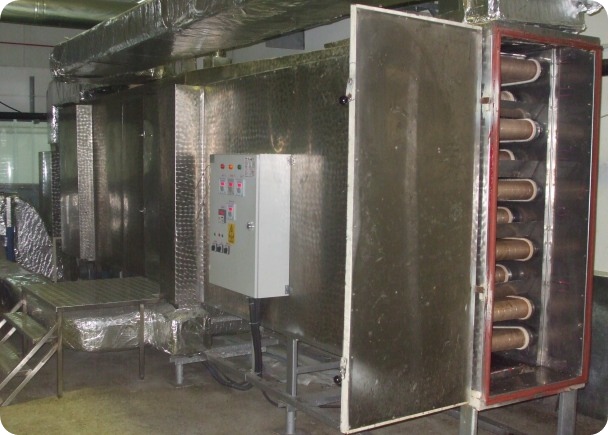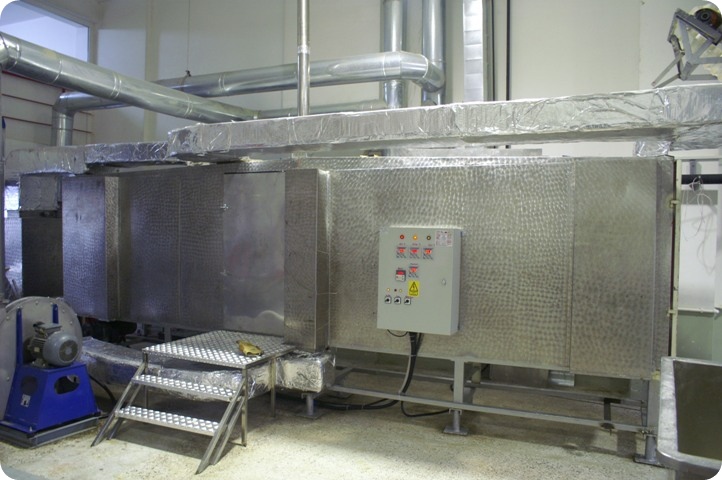Machines of Industrial Drying Systems
| BELT DRYER
The conveyor dryer is conceptually very simple. Product is carried through the dryer on conveyors and hot air is forced through the bed of product. It is often described as simply a conveyor in a box with hot air. The reality, however, is that the conveyor dryer is one of the most versatile dryers available. Few drying technologies can match the conveyor dryer’s ability to handle such a wide range of products. Products as varied in composition, shape, and size as coated breakfast cereals, nuts, animal feed, charcoal briquettes, and rubber can be dried in a conveyor dryer.
THE ADVANTAGES OF BELT DRYER
1 -) Special machine design according to the product.
2 -) Uniform drying due to movement of product.
3 -) Effective use of Drying Air circulation fans.
4 -) Heat recovery system can be added to the dryer in accordance with customer demand.
5 -) Multi stage belt systems can be used.
6 -) can easily be controlled belt speed and drying time.
7 -) Less workers make same work according to tray drying system
8-) Dryer can be use at continuous systems.
9 -) Can be use most of sectors.
VALUES OF INLET AND OUTLET MOISTURE OF PRODUCTSProduct | Initial moisture content (%) | Outlet Moisture Content (%) | Product | Initial moisture content (%) | Outlet Moisture Content (%) | Sage | 62 | 11 | Cocoa | 50 | 6-7 | Pears | 84 | 25 | Cardamom | 80 | 16 | Salvia | 71 | 11 | Coated cucumber / red radish seeds | 36 | 9 | Okra | 81 | 6 | Apricot | 85.3 | 25 | Peas | 60-70 | 5-10 | Thyme | 72.9 | 7.5-11,4 | Rosemary | 70 | 10 | Cherry | 81 | 30 | Dill | 70-80 | 10 | Cabbage | 90-95 | 5-10 | Tomato | 93 | 7 | Parsley | 83 | 12 | Apple | 84.8 | 24 | Banana | 80 | 15 | Plum | 78.7 | 35 | Mint | 80 | 11 | Beans | 60-70 | 5-10 | Melissa | 77 | 11 | Basil | 80 | 6 | Potato | 77 | 7 | Chervil | 80 | 12 | some flowers | 70 | 10-13 | Chives | 80-85 | 12 | Daisy | 75 | 7 | Carrots | 80-90 | 5-10 | Garlic | 80 | 4 | Coconut | 45-50 | 5 | Onion | 84 | 6 | Indian yams | 70 | 15 | Peach | 75-80 | 20 | Indian yams | 70 | 15 | Sugar cane | 40-60 | 20 | Date | 65 | 40 | Hop | 77 | 8 | Spinach | 80 | 10 | Grape | 74 to 81.6 | 15-18 | Figs | 77.5 | 26 | Cherry | 83.7 | 25 | Red pepper | 90 | 20 | Green pepper | 80 | 10 | Marigold | 72-85 | 12 | Peanut | 45-50 | 13 | Coffee | 43-48 | 12 | Ginger | 87-93 | 5 |
These values Assoc. Dr. Can Ertekin "Some dried fruits and vegetables" s article 2 taken from tabulation. USING AREAS OF BELT DRYERcooked lentils | Dry Bread Crumbs of bread crumbs | Coal Drying | PVB | Pine Sawdust | Drying Hazelnuts | Sand Drying | PVC | Bentonite Drying | Recycling Products | Quartz | Diced potatoes | Fish meat | Food Additives | Drying leonardite | Shredded Roots | Drying Fish Food | Preservatives in Food | Marble Powder | Sucrose | CMC | Manure Drying | Licorice | Soybean Drying | Tea Drying | Carrot Drying | Peel of citrus fruit and | Chipboard (Chip Board) | Flowers (pollen Hexanol) | Fine Shredded Potatoes | Wood Drying | Sugar Drying | Garbage, waste, pulp, etc. | Coffee Drying | Herbs and Spices | Spice Powder and Granules | Drying Seaweed | Rock Salt | Drying Cotton | Drying Salt | Stool, dirt, sediment | Red Brick Drying | Paprika (Red Pepper) | Jerusalem artichoke | Natural Herbs | Melba toast | Potato Residue | Drying Peanuts | Drying Cheese | Rice Drying | Drying of orange peel | Wool |
|
| | |
